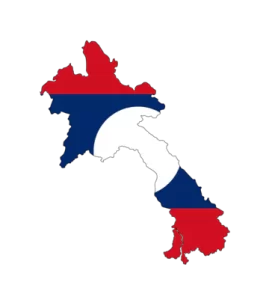Geographical Position and Climate of Laos
Laos is a landlocked country situated in Southeast Asia, bordered by China to the north, Vietnam to the east, Cambodia to the south, Thailand to the west, and Myanmar to the northwest. The country’s geography is characterized by mountainous terrain with the Annamite Range in the east and the Mekong River running as a major geographical feature, which forms a large portion of its border with Thailand.
The climate in Laos is tropical and monsoonal. It has two distinct seasons: the rainy season from May to October due to the southwest monsoon, and the dry season from November to April, influenced by the northeast monsoon. The rainy season can bring heavy showers and high humidity, while the dry season is cooler and more temperate. Temperatures during this time can vary considerably – warmer in the lowlands and cooler in the highlands. In Vientiane, for instance, average temperatures range from 14°C to 38°C throughout the year.
Brief history of Laos
Early History
Laos has a rich history that dates back thousands of years. The region was inhabited by agricultural communities as early as the 4th millennium BC. By the 14th century, the kingdom of Lan Xang was established by Fa Ngum, which means “Million Elephants,” signifying strength and prosperity.
Lan Xang Kingdom
Lan Xang thrived as a powerful kingdom in Southeast Asia for several centuries. It was a hub for overland trade and had strong cultural ties with its neighbors. However, by the 18th century, the kingdom became weakened due to internal conflicts and was eventually divided into three separate principalities.
Colonial Era
In the late 19th century, Laos came under French colonial rule as part of French Indochina. This period introduced new administrative systems, infrastructure, and education but also led to exploitation and resistance among the Laotian people.
Path to Independence
During World War II, Laos was occupied by Japanese forces. After the war, it briefly gained independence but soon after faced a civil war involving royalists, communists, and neutral factions. Full sovereignty was achieved in 1953, but the country remained embroiled in conflict, influenced by the larger Vietnam War.
Modern Era
In 1975, the communist Pathet Lao movement took control of the government, establishing the Lao People’s Democratic Republic. Since then, Laos has been a one-party socialist republic. It has gradually opened up to the world, joining ASEAN in 1997 and the WTO in 2013. Despite economic reforms and development, Laos still faces challenges related to poverty and governance.
Religion of Laos
The predominant religion in Laos is Theravada Buddhism, which is practiced by around two-thirds of the population. It plays a central role in Lao culture and society, influencing art, literature, and daily rituals. Apart from Buddhism, there are also practitioners of other religions in Laos, including: Animism, Christianity and Islam.
Language of Laos
The official language of Laos is Lao, also known as Laotian. It is the primary language used in government, education, and media. Lao belongs to the Tai-Kadai language family and is closely related to Thai, with which it shares many linguistic similarities.

Places to visit in Laos
- Vientiane
- Luang Prabang
- Savannakhet
- Phou Khao Khouay National Park
- Dong Hua Sao National Protected Area
- Bokeo Nature Reserve
Before you visit Laos
Travel to Laos
By Air
The most common and convenient way to enter Laos is by air. The country has several international airports:
- Wattay International Airport (VTE) in Vientiane, the capital.
- Luang Prabang International Airport (LPQ) in the UNESCO World Heritage city of Luang Prabang.
- Pakse International Airport (PKZ) in the southern part of the country.
These airports offer flights to and from various destinations in Asia, with connections to major cities around the world.
By Land
Laos shares borders with China, Vietnam, Cambodia, Thailand, and Myanmar, and there are multiple border crossings from these countries:
- Thailand: There are several popular crossings such as the Friendship Bridge near Vientiane and crossings at Huay Xai and Chiang Khong for access to northern Laos.
- Vietnam: Key border points include Lao Bao-Dansavanh and Nam Phao-Cau Treo.
- Cambodia: The main crossing is at Veun Kham/Dom Kralor.
- China: You can enter through the Boten-Mohan border crossing.
- Myanmar: A less commonly used crossing is at the border of Myanmar and Laos at the Xiangkok river port (note that this crossing may not always be open to foreign travelers).
By Water
For a more scenic route, you can enter Laos by boat:
- From Thailand: Travel by boat along the Mekong River to Pakbeng or Luang Prabang.
- From Cambodia: Take a boat up the Mekong River from Phnom Penh or Siem Reap towards southern Laos.
When planning your trip to Laos, it’s important to check visa requirements and ensure that border crossings are open, as regulations can change. Overland travel may also require additional planning due to varying transportation schedules and local conditions.
